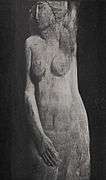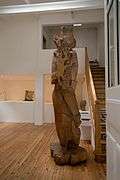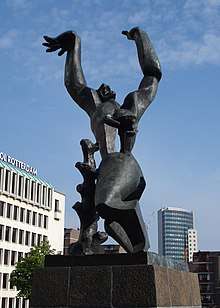Ossip Zadkine
Ossip Zadkine (Russian: Осип Цадкин; 28 January 1888 – 25 November 1967) was a Russian-born French naturalized artist. He is primarily known as a sculptor, but also produced paintings and lithographs.[1]
Ossip Zadkine | |
|---|---|
 Zadkine in 1914 | |
| Born | Yossel Aronovich Tsadkin 28 January 1888 |
| Died | 25 November 1967 (aged 79) Paris, France |
| Resting place | Cimetière Montparnasse |
| Known for | Sculpture, painting, lithography |
| Movement | Cubism, Art Deco |
Early years and education
Zadkine was born on 28 January 1888 as Yossel Aronovich Tsadkin (Russian: Иосель Аронович Цадкин) in the city of Vitsebsk, part of the Russian Empire (now Belarus).[2][3][4] He was born to a Jewish father and a mother named Zippa-Dvoyra, who he claimed to be of Scottish origin.[5] Ossip had 5 siblings: sisters Mira, Roza and Fania and brothers Mark and Moses.
At the age of fifteen, Zadkine was sent by his father to Sunderland to learn English and ‘good manners’. He then moved to London and attended lessons at the Regent Street Polytechnic where he considered the teachers to be too conservative.[6]
Zadkine settled in Paris in 1910. He studied at the École des Beaux-Arts for six months. In 1911 he lived and worked in La Ruche. While in Paris he joined the Cubist movement, working in a Cubist idiom from 1914 to 1925. He later developed his own style, one that was strongly influenced by African and Greek art.[7]
Career
In 1921 he obtained French citizenship.[5] Zadkine served as a stretcher-bearer in the French Army during World War I, and was wounded in action. He spent World War II in the US. His best-known work is probably the sculpture The Destroyed City (1951-1953), representing a man without a heart, a memorial to the destruction of the center of the Dutch city of Rotterdam in 1940 by the German Luftwaffe.[8]
He taught sculpture classes at Académie de la Grande Chaumière until 1958, students of his included artists Geula Dagan (1925–2008) and Genevieve Pezet.[9]
Death and legacy
Zadkine died in Paris in 1967 at the age of 79 after undergoing abdominal surgery[8] and was interred in the Cimetière du Montparnasse.
Museums
His former home and studio in Montparnasse is now the Musée Zadkine.[10] When his former wife Prax died, she donated the house and art studio to the City of Paris for the formation of Musée Zadkine.[10]
There is also a Musée Zadkine in the village of Les Arques in the Midi-Pyrénées region of France. Zadkine lived in Les Arques for a number of years, and while there, carved an enormous Christ on the Cross and Pieta that are featured in the 12th-century church which stands opposite the museum.
Personal life
In August 1920, Zadkine married Valentine Prax (1897–1981), an Algerian-born painter of Sicilian and French-Catalan descent.[11][12] Prax and Zadkine had no children.[13]
Zadkine was a neighbor in Montparnasse and a friend of Henry Miller and he was represented by the character "Borowski" in Miller's novel, Tropic of Cancer (1934).[10][14][15] His other neighbors there included; Chaim Soutine, and Tsuguharu Foujita.[10]
While living in exile during wartime in Manhattan from 1942 to 1945, Zadkine had a relationship with American artist Carol Janeway and he created several portraits of her.[16]
The artist's only child, Nicolas Hasle (born 1960), was the result of his affair with a Danish woman, Annelise Hasle.[17] Since 2009, Hasle, a psychiatrist, who had been acknowledged by the artist and had his parentage legally established in France in the 1980s, has been party to a lawsuit with the City of Paris to establish his claim to his father's estate.[18][17][19]
Awards
- 1950 Venice Biennale sculpture prize[20]
- 1961 Grand Prix National des Arts[20]
Legacy
Gallery
 Maternité, 1913,painted elmwood, 81 cm, exhibited at the 1914 Salon des Indépendants, Paris, Published in Montjoie, 1914
Maternité, 1913,painted elmwood, 81 cm, exhibited at the 1914 Salon des Indépendants, Paris, Published in Montjoie, 1914.jpg) Femme au violon (Woman with a Violin), 1918 photograph by Pierre Choumoff
Femme au violon (Woman with a Violin), 1918 photograph by Pierre Choumoff Venus, 1920, published in Action: Cahiers individualistes de philosophie et d'art, Volume 1, Number 4, July 1920
Venus, 1920, published in Action: Cahiers individualistes de philosophie et d'art, Volume 1, Number 4, July 1920.jpg) Sundial, 1929, bronze sculpture, Museum de Fundatie, castle Heino, Netherlands
Sundial, 1929, bronze sculpture, Museum de Fundatie, castle Heino, Netherlands Prometheus, c. 1930–1940, wooden sculpture
Prometheus, c. 1930–1940, wooden sculpture.jpg) The prisoners (Die Gefangenen), 1943, bronze sculpture
The prisoners (Die Gefangenen), 1943, bronze sculpture The Destroyed City (De Verwoeste Stad), 1951–53, bronze sculpture in Rotterdam, which is now a registered monument.[23]
The Destroyed City (De Verwoeste Stad), 1951–53, bronze sculpture in Rotterdam, which is now a registered monument.[23] Orpheus, 1956, bronze sculpture
Orpheus, 1956, bronze sculpture Lotophage, 1961–62, bronze sculpture, Tel Aviv Museum of Art, Tel Aviv
Lotophage, 1961–62, bronze sculpture, Tel Aviv Museum of Art, Tel Aviv- Vincent and Theo van Gogh, 1963–64, bronze sculpture, in Zundert, The Netherlands
Public collections
Among the public collections holding works by Ossip Zadkine are:
See also
References
- Zadkine Research Center
- "Une enfance en Russie". paris.fr.
- "Александр Лисов. Цадкин и Витебск". chagal-vitebsk.com. Archival materials reported in this article state that Iosel-Shmuila Aronovich Tsadkin, was of Jewish faith and studied in the Vitebsk City Technical School between 1900 and 1904, including two years in one class with would-be artists Marc Chagall (then Movsha Shagal) and Victor Mekler (then Avigdor Mekler). Thus, contrary to what Zadkine himself was saying, his father did not convert to the Russian Orthodox religion and his mother was not of a Scottish extraction.
- "Людмила Хмельницкая. Витебское окружение Марка Шагала". chagal-vitebsk.com.
- Ossip Joselyn Zadkine Facts, YourDictionary
- "Ossip Zadkine, 1888-1967". Sculpture International Rotterdam.
- "La source grecque, l'enracinement d'une "terre"". paris.fr.
- "Sculptor Dies". The Age. 27 November 1967. Archived from the original on 15 January 2013. Retrieved 20 April 2010.
- Hauer, Caroline (2019-03-20). "Paris: Le Messager, une oeuvre monumentale d'Ossip Zadkine - Quai d'Orsay - VIIème". Paris la Douce (in French). Retrieved 2020-06-12.
- "Musée Zadkine". Artist's Studio Museum Network. Retrieved 2020-06-12.
- Birnbaum, Paula J. (2017). Women Artists in Interwar France: Framing Femininities. Routledge. p. 130. ISBN 9781351536714.
- Wolpert, Martin; Winter, Jeffrey (2004). Modern Figurative Paintings: The Paris Connection. Schiffer Publishing. ISBN 9780764319624.
- "Prax, Valentine Henriette". Benezit Dictionary of Artists, Oxford Art Online. doi:10.1093/benz/9780199773787.article.b00145672. Retrieved 2020-06-12.
- "Musée Zadkine". Walking Paris with Henry Miller. Archived from the original on 2016-03-04.
- Frederick Turner: Renegade: Henry Miller and the Making of "Tropic of Cancer", Yale University Press, 2012.
- Art, Philadelphia Museum of. "Philadelphia Museum of Art - Collections Object : Carol Janeway with Zadkine Sculpture". philamuseum.org. Retrieved 2017-04-13.
- "Paris Must Justify Right To Sculptor Ossip Zadkine's Estate". Artforum.com. 2011-03-31. Retrieved 2020-06-12.
- "The Art Newspaper". theartnewspaper.com.
- "Ossip Zadkine: Who Owns the Sculptor's Estate?". Center for Art Law. 2011-04-03. Retrieved 2020-06-12.
- "Ossip Zadkine – Obituary". The Montreal Gazette. 27 November 1967. Retrieved 20 April 2010.
- Zadkine college
- Zadkine Airlines Rotterdam
- Rijksmonumenten
- Czwiklitzer, Christophe, Ossip Zadkine, le sculpteur-graveure de 1919 à 1967, Paris, Chez l'auteur, 1967.
- Yamanashi Kenritsu Bijutsukan, Ossip Zadkine, Tokyo, Yomiuri Shinbunsha, 1989.
- Andreas Weiland, "(Re-)Discovering Zadkine", in: Art in Society, issue # 10
External links
| Wikimedia Commons has media related to Ossip Zadkine. |
| Wikiquote has quotations related to: Ossip Zadkine |
- Zadkine Research Center
- Works by or about Ossip Zadkine at Internet Archive
- Zadkine Museum in Paris
- Zadkine Museum in Les Arques
- Ossip Zadkine in American public collections, on the French Sculpture Census website
